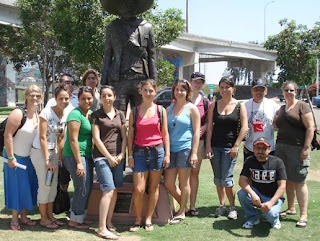August 22, 2008
By Rebecca Marcus and Alison Ecker
University of Oregon

(Editor’s Note: A University of Oregon class of 15 students, headed by Edward Olivos of San Diego, spent a week at the Tijuana/San Diego border for a week of hands-on training and understanding on the issue of immigration. During the week, students spent time on both sides of the border, helping with relief efforts and interacting with immigrants.
We invited the students to share with our readers their experience and their perspective on the immigration issue.)
When most people think of Tijuana and college students, what comes is mind is tequila, parties, and wild abandon. Who would believe it then that a university professor would lead a class to this infamous party town with actual educational intent?
We are two seniors from the University of Oregon, both coming from families that are generations removed from the immigration experience. Between the two of us our fields of study include geography, environmental studies, ethnic studies and Italian. So what drew us to a class on immigration and diaspora?
When we found out an education studies class was going to be offered as a week-long intensive field studies course in San Diego and Tijuana, we jumped at the opportunity to learn first-hand a piece of the immigrant story.
The 11 Uuniversity of Oregon students at Chicano Park with muralist Salvador Barajas.
My (Rebecca) interest in immigration comes from researching Russian and Ukrainian immigrants and refugees in Oregon through the Department of Geography. I chose to take this class because I wanted to learn about a different immigrant story, one I could not relate to, that of Latinos coming to the U.S. I wanted to humanize the immigrants I too often look at only as statistics and to meet the people and organizations that support these immigrants in their journey.
As an ethnic studies major (Alison), I found out about this class almost right away through a department email, and was one of the first students to sign up. I love my field of studies, which allows me to study diversity issues and gain a new understanding and cultural awareness of minority groups. I had not studied immigration issues in depth, especially relating to Latinos, but it was a topic that I was extremely interested in, and a group of people that I have had the most contact with in my own community. But probably the most important and appealing aspect of this class was the fact that it was a hands-on experience to take place in San Diego and Tijuana. I felt like this was a unique opportunity to make the immigrant experience real, one that I just couldn’t miss.
Our home state of Oregon, especially the Western part, is often thought of as white, liberal and less touched by immigration than the Mexican border-states of California, Arizona, and Texas. However, immigration is becoming more real to many Oregonians, drawing strong voices from all sides of the issue due to the increasing immigrant population in the state.
The strong emotions surrounding this topic are present even among students, surfacing in one incident when an article was published in the student newspaper highlighting the immigration research by a university professor. The article drew heavy criticism and racist comments simply because of its headline, which called the city of Woodburn (north of the capital of Salem), a “Little Mexico,” for its large Latino population.
During our week of field studies we participated in a wide range of activities from refilling water stations in the desert of Imperial County to exploring the reclamation of space through murals in Chicano Park.
We met migrant workers living in North County, waiting for work, and were enormously struck by their patience, sense of humor and faith. We followed the immigrant trail to Tijuana where we were moved by the first-hand stories of deported women who were working to build new lives in Tijuana.
We felt the uneasiness and intimidation of crossing the border into the United States and tried to imagine the feelings of those who had crossed through the desert instead. Following the immigrant trail back to Oregon, we met groups who work with immigrants in our own community.
After a short eight days of class we found ourselves struggling to process all of our experiences.
We faced an array of emotions from guilt, to sadness, anger, admiration and gratitude, which surfaced in our daily seminars. Hearing the thoughts and opinions of our classmates coming from diverse personal backgrounds and fields as varied as architecture, family and human services, psychology and education was as valuable a learning experience as our daily field work. We traveled all the way to the border of Mexico and came back to our home state with an enriched perspective on the immigrant experience that is increasingly becoming part of our lives.
We were struck by the sensitivity and enormity of this issue. Many people seem to avoid discussing and examining immigration because it can be such a politically charged issue. Even those who are fairly like-minded may discover a continuum of thought and emotions on the subject, as we found to be the case among our classmates. But in doing our fieldwork, we unearthed the compelling stories of human beings that lie beneath the tension of the political debate.
Throughout this class, we were able to put faces on a few of the footprints we saw in the desert, and watch their stories unfold from Tijuana to Oregon. However, our short but intense journey covered only a fraction of the greater story; there are voices on all sides of this complex immigration issue that should be heard. After all, as we learned from this class, every human being deserves the same dignity and respect regardless of our diverse beliefs.
No comments:
Post a Comment